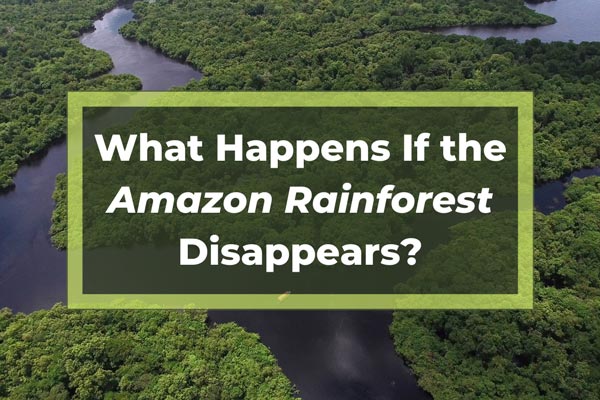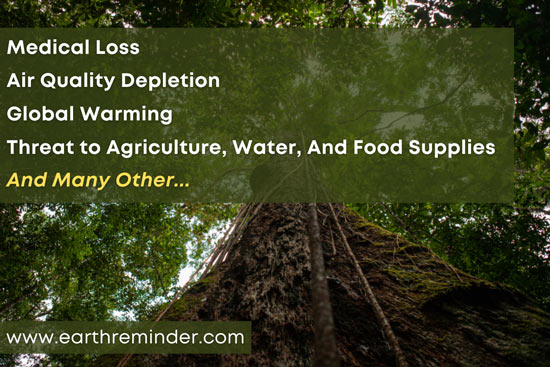What Happens If the Amazon Rainforest Disappears?
What Happens If the Amazon Rainforest Disappears?
The Amazon Jungle or Amazonia is an alternative term for the Amazon Rainforest and refers to the moisture-rich broadleaf tropical rainforest in South America’s Amazon Basin.
Approximately 2,100,000 square miles of the South America basin are covered by the Amazon Forest. The forest spread itself around the following locations:
- 58.4% of the rainforest within Brazil.
- 12.8% by Peru.
- 7.1% by Colombia.
- Minor amounts by 6 other locations, such as Ecuador- 1%, French Guiana-1.4%, Suriname-2.5%, Venezuela-6.1%, Bolivia-7.7%, Guyana-3.1%.
Flora and Fauna: The Amazon rainforest is home to one out of every ten species known to exist in the world. Mammals, approx. 2000 birds, 2.5 million insects live in this region.
Windblown to the Amazon: It is estimated that 56% of the dust that fertilizes the Amazon rainforest originates from the Sahara Desert. The dust has possession of phosphorus, which plays an essential role in plant growth.
Table of Contents
- 1 How Much of the Amazon Rainforest Is Left?
- 2 What Happens If Amazon Rainforest Disappears?
- 2.1 Medical Loss:
- 2.2 Destruction in Respect of World Species:
- 2.3 Dry Weather and a Massive Amount of Flooding:
- 2.4 Global Warming Process:
- 2.5 Threat to Agriculture, Water, And Food Supplies:
- 2.6 Variety of Food Across the World:
- 2.7 The Air Quality Depletion:
- 2.8 Forest Fires:
- 2.9 No Homes:
- 2.10 Plants That Are Active Against Cancer:
How Much of the Amazon Rainforest Is Left?
Human settlements and the development of land in the Amazon basin are among the main causes of deforestation. The colonists were unable to manage the fields and the soil lost its moisture and weed invasion.
It’s been noticed that soil was productive for a short period of time therefore farmers kept on moving and clearing more land. Areas that got cleared were visible from space even through the naked eye. The major threat to amazon was—Trans-Amazonian Highway.
Brazil was the one that experienced a tremendous growth period. This meant encroachment into Amazon.
Sixty percent of the forest resides in Brazil borders, and with the development of the country, most of the area got cleared. 17–20% of the Amazon has already been cleared in 50 years.
The following shows the availability of the Amazon rainforest:
- Year 2020 – 80.3% remaining
- 2019 – 80.5% remaining
- Year 2018 – 80.7% remaining.
What Happens If Amazon Rainforest Disappears?
Medical Loss:
The pharmaceutical industry would face a tremendous amount of loss. Ninety percent of diseases are treatable with the drugs provided by the nature of the Amazon. The medical world mainly depends on the Amazon rainforest. If the forest degrades so does the medical sector.
Approx. 121 prescribed drugs including the drugs for leukemia, glaucoma is sourced from it. Moreover, the drugs to cure heart disease are sourced largely from the forest. 1% of 80,000 plant species have been tested for medicinal potential.
Destruction in Respect of World Species:
- Half of the world’s species reside in Amazon Rainforest. With the depletion of rainforests, the home of such species is also destroying.
- Ten percent of world species including 40,000 plant species, 370 reptiles, 2.5 million insects and 3000 freshwater fish finds their home at Amazon.
- We’re losing an estimated 137 species of plants, animals, and insects every single day all over the world. If this rate continues, the world will lose half of the species including all the endangered species.
Dry Weather and a Massive Amount of Flooding:
With the current situation, the rainfall rate decreased a great amount. The causes would lead to—ripple effect, an additional shift in climate change, desiccation, longer aridity, flooding in a high amount.
Global Warming Process:
The plant absorbs carbon dioxide. Observing the current scenario, the destruction would lead to emission of carbon in great amount; This would affect the air quality and temperature leading to the global warming process.
Threat to Agriculture, Water, And Food Supplies:
The destruction and disappearance of the Amazon rainforest will lead to warmer temperatures, frequent floods, and long droughts; The gradual decrease in rainfall would increase the pest and infection and less water will minimize the resources of sowing and maintaining crops.
Variety of Food Across the World:
- A huge percentage of the world’s food gets originated from the forest.
- Losing the Amazon Rainforest would affect our food supply as the forest contains over 3000 edible fruits such as oranges, lemons, avocado, mangoes, pineapple, figs, banana, coconut, etc.
The Air Quality Depletion:
- Burning down of this forest will lead to emission of carbon in great amount.
- It will become a great source of emission rather than storage. The destruction would mean stopping the recycling of CO2 into oxygen.
Forest Fires:
Dry weather will prevail due to a decrease in the amount of rainfall. If the temperature boosts around 3 degrees Celsius, it will result in a natural occurrence of fire that will wipe 75% of the Amazon Rainforest. Man-made fires still anguish the forest.
No Homes:
There are on average 30 million people around the globe who find their shelter in the rainforest. 2.7 million people are indigenous. 350 ethnic groups of people find shelter in the Amazon rainforest.
Talking about Amazon rivers, they bring an immense amount of benefit to the people globally. Approx. talking 175,000 cubic meters of freshwater is discharged into the Atlantic Ocean.
Plants That Are Active Against Cancer:
With the loss of Amazon, the world would lose around 70% of 3000 plants that provide active particles against cancer and heart disease.
Periwinkle, the world’s influential drug for cancer, this drug alone has drastically saved lots of children who suffered from subtle leukemia; This drug is withdrawn from the rainforest plant Vincristine.
The above would be faced by us if the question—What happens if the Amazon Rainforest disappears? Clicks our minds again.
With the above points, it’s quite clear that the disappearance of Amazon will surely lead us to the end game of destruction. And, With the fire of 2019, the world had largely seen the consequences and the impacts are still prevailing. Amazon Rainforest acts as the lungs for the Earth and suffocating the lungs would lead to our destruction.

